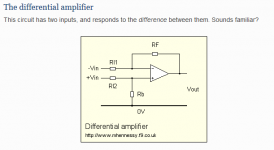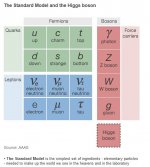No worries, guys. I've always been much too quick to get offended over little things that should blow right by me. Combine that with a lack of impulse control that goes with ADD and you get things like me posting my ISCET electronics tech certification from 1994, then regretting it 60 seconds later.
I did spend 4 hours every weekday for 2 years having electronic circuits drilled into my brain. But I have forgotten a very large percentage of it since I ended up switching my career to computer related stuff within a few years of graduating.
-Chris
I did spend 4 hours every weekday for 2 years having electronic circuits drilled into my brain. But I have forgotten a very large percentage of it since I ended up switching my career to computer related stuff within a few years of graduating.
-Chris
Not really. All he's doing is putting in networks which will cause the frequency response to be independent of source impedance, whether it's low, high, or in the middle. There's nothing special about having it be 2, 4, 5, 8, whatever ohms.
Agreed!
But what explanation that this 'isolation' of the crossover (not my description but an engineer friend of mine) in the sense it takes the crossover out of the way - I know, a matter of how you look at this, and it all conforms to Ohm's Law (we have left Kuala Lumpur behind I see 😀) which can be rediscovered all over again in the sense of power transfer, when current gets converted to voltage and on and on we go in circles. We all know this stuff and hence for two days just been rehashing for no other reason that showing others what we know.
Nothwithstanding bringing up the need for more of the dreaded blind test stuff, that the simple technique that I have employed, so simple that those who wish it can just ignore and dismiss it, yet can't explain what it does for the sound? IF it improves the sound, then (let's not go down the KL route again), an explanation that goes beyond Ohm's Law has to be found.
But of course, that comes down to simple act of listening - not arguing about Ohm's Law - for which there is no argument because that is already set in cement and we all know it. IF there are aberrations, then Ohm's Law will still fit in, it's just that we don't see how yet.
But it still comes down to the listening and asking why does this make a difference. Somewhat of a reluctance to do that here. 😀
So IF it makes a difference to the sound, the HOW would you explain it?
THAT is what this boils down to, NOT an endless rehashing of Ohm's Law.
Until there is a willingness to do that, I will sit on the sidelines.
So IF it makes a difference to the sound, the HOW would you explain it?
You haven't demonstrated that this is true yet, so my "explanation" is "just one more claim with no evidence."
an explanation that goes beyond Ohm's Law has to be found.
Joe I continue to not understand, Ohm's law has nothing to do with the sound of a particular set of drivers/crossover/amp. I have never seen anyone use it to prove they had a best configuration, everyone of which has its own SPL vs frequency/power and radiation pattern.
I just looked up some reviews of the Pioneer A400X, the first and possibly only amp I had a problem with on the thread topic. Scenario: simple cross at 2-4k, Scan-Speak drivers, 1x series RLC conjugate.So IF it makes a difference to the sound, the HOW would you explain it?
There was a slight harshness with a euphonic quality (which the amp is known for anyway). It uses moderate global feedback, ie. enough but also not enough (like 12dB or something). It's sensitive to the load.
My wild a$$ guess is poor local feedback choices and using complex topology to tailor stage distortion. Not my cup of tea.
Agreed!
But what explanation that this 'isolation' of the crossover (not my description but an engineer friend of mine) in the sense it takes the crossover out of the way - I know, a matter of how you look at this, and it all conforms to Ohm's Law (we have left Kuala Lumpur behind I see 😀) which can be rediscovered all over again in the sense of power transfer, when current gets converted to voltage and on and on we go in circles. We all know this stuff and hence for two days just been rehashing for no other reason that showing others what we know.
Nothwithstanding bringing up the need for more of the dreaded blind test stuff, that the simple technique that I have employed, so simple that those who wish it can just ignore and dismiss it, yet can't explain what it does for the sound? IF it improves the sound, then (let's not go down the KL route again), an explanation that goes beyond Ohm's Law has to be found.
But of course, that comes down to simple act of listening - not arguing about Ohm's Law - for which there is no argument because that is already set in cement and we all know it. IF there are aberrations, then Ohm's Law will still fit in, it's just that we don't see how yet.
But it still comes down to the listening and asking why does this make a difference. Somewhat of a reluctance to do that here. 😀
So IF it makes a difference to the sound, the HOW would you explain it?
THAT is what this boils down to, NOT an endless rehashing of Ohm's Law.
Until there is a willingness to do that, I will sit on the sidelines.
Will we have been here before too.
Current source (or amp with high output Z) : Makes a difference is the sound because it significantly changes the frequency response.
Voltage source: If it makes a differences in the sound there is a problem with the amplifier driving the uncompensated load.
End of discussion.
Last edited:
I must be to audio what Mozart was to Written Music. I mean, show me a speaker and a crossover, and I can hear it in my head. Here's Joe's Usher S520 project. 😀
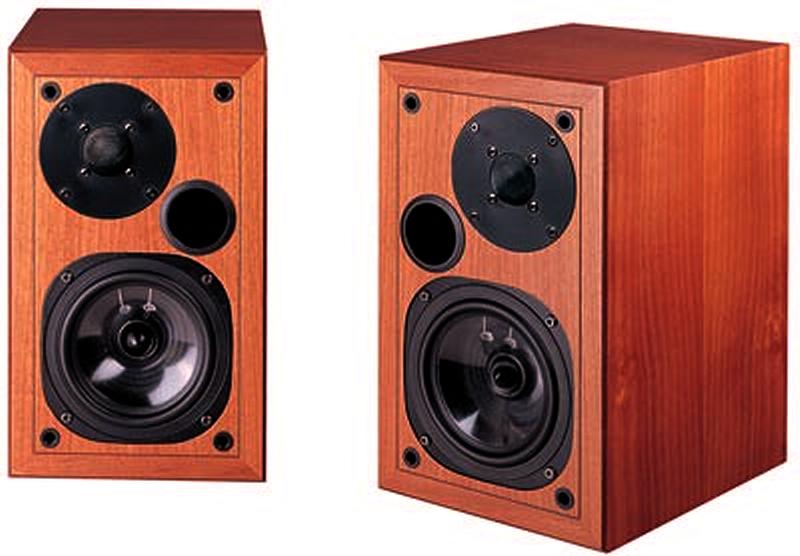
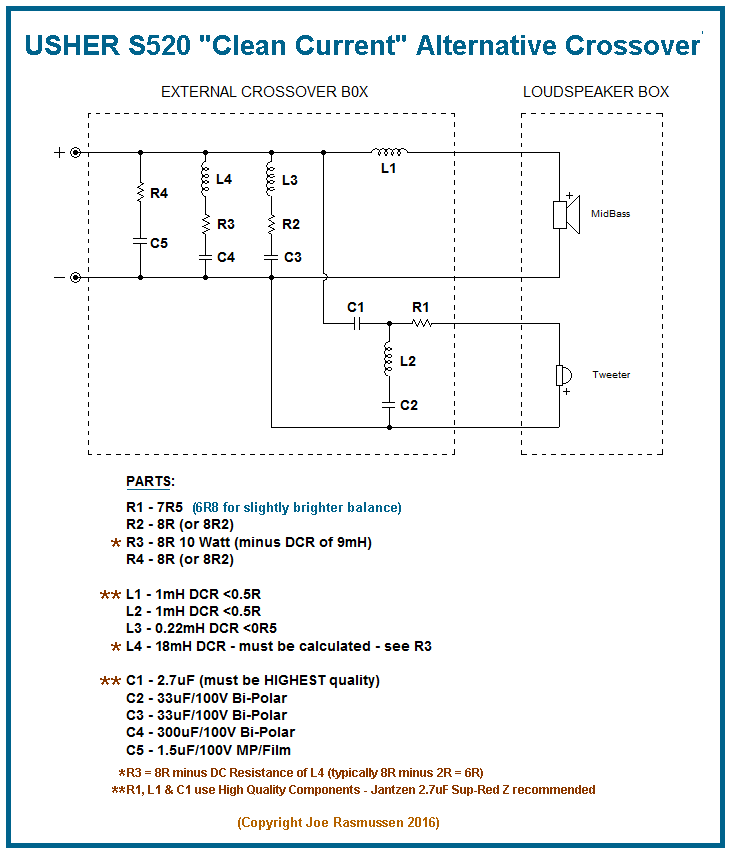
Nice piece of work IMO. Improving cheapie commercial speakers is ideal diy material. We all like this stuff, it's what diyaudio should be about. Now he's done a bit more than tediously "Upgrade" the caps.
So the only question that remains: IS THIS AUDIO VOODOO? Or is he onto something here with the flat impedance idea?
I can't explain simply why resistive loads are a GOOD THING. But they are. They don't store energy. In audio we do terribly sloppy things, things a Radio Frequency engineer would never go near.
Knowledge is always limited, but INSIGHT into how stuff works is a surer guide.
Here's how 3 way speakers work courtesy of Steen Duelund:

Here's how the box and the room interact:
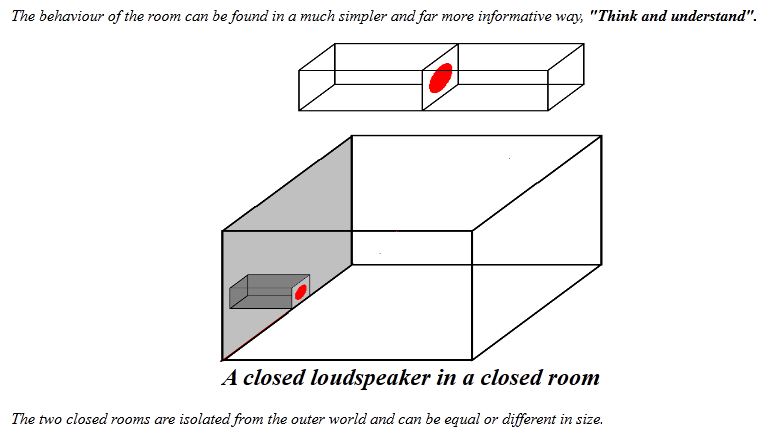
Here's why valves and transistors and MosFETs get to the same place:
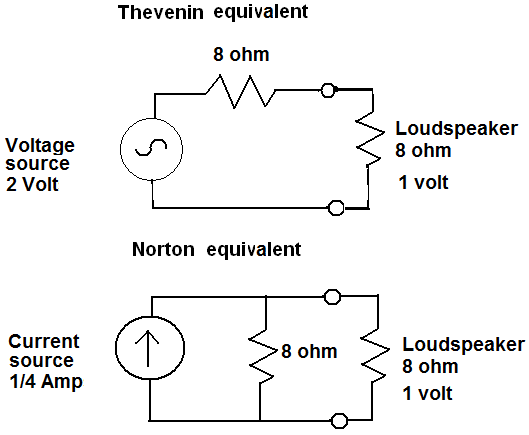
Here's everything you need to know about diffraction:
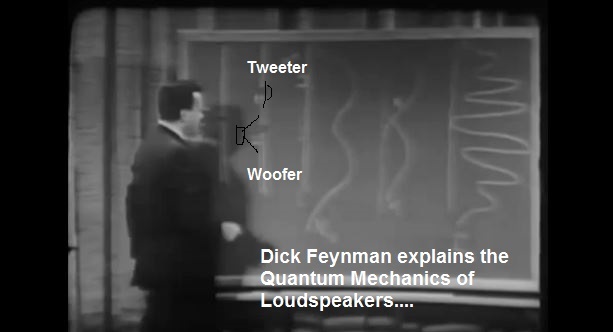
I am totally convinced that what Joe is hearing is essentially an amplifier effect. Lot of sloppy compromises in audio amplifiers, one of the worst of which is poor common-mode rejection. Common Mode is noise from the Earth rail. You can hear it.
The correct condition for optimum common mode rejection is matched ratio resistors in the two arms, but I have rarely seen it correctly done in audio. 😕
Now if you want to continue to ramble on about Ohm's Law, please do. But I use much more advanced ideas like Maxwell's Equations and Shannon's Noiseless Encoding Theorem and Quantum Mechanics. One of my better, if more irritating posts.


Nice piece of work IMO. Improving cheapie commercial speakers is ideal diy material. We all like this stuff, it's what diyaudio should be about. Now he's done a bit more than tediously "Upgrade" the caps.
So the only question that remains: IS THIS AUDIO VOODOO? Or is he onto something here with the flat impedance idea?
I can't explain simply why resistive loads are a GOOD THING. But they are. They don't store energy. In audio we do terribly sloppy things, things a Radio Frequency engineer would never go near.
Knowledge is always limited, but INSIGHT into how stuff works is a surer guide.
Here's how 3 way speakers work courtesy of Steen Duelund:

Here's how the box and the room interact:

Here's why valves and transistors and MosFETs get to the same place:

Here's everything you need to know about diffraction:

I am totally convinced that what Joe is hearing is essentially an amplifier effect. Lot of sloppy compromises in audio amplifiers, one of the worst of which is poor common-mode rejection. Common Mode is noise from the Earth rail. You can hear it.
The correct condition for optimum common mode rejection is matched ratio resistors in the two arms, but I have rarely seen it correctly done in audio. 😕
Now if you want to continue to ramble on about Ohm's Law, please do. But I use much more advanced ideas like Maxwell's Equations and Shannon's Noiseless Encoding Theorem and Quantum Mechanics. One of my better, if more irritating posts.
Attachments
Will we have been here before too.
Current source: Makes a difference is the sound because it significantly changes the frequency response.
No! Given examples earlier that proves otherwise. Dismissed!
Voltage source: If it makes a differences in the sound there is a problem with the amplifier driving the uncompensated load.
Not related to the amplifier? Been exhaustively demonstrated with tube amps with output impedances between 0.5 Ohm to 10 Ohm, voltage sources down to 0.1 Ohm, current sources up to 270 Ohm.
Tonal changes ZERO!
No frequency response change to cause it. SoundEasy proves it.
Yet there is a NOTICEABLE INCREASE IN CLARITY.
Sorry, don't want to give the impression of shouting, just giving an appropriate emphasis that THIS is what the thread is about.
This is NOT related to frequency response - I am surprised you did see the earlier proof I posted. Would you like me to repost?
John, you continually underestimate the capabilities of others to be inferior to your own and it shows up in your dismissive tone. You even said about one speaker design of mine that it could cause possible oscillations (around 2KHz if memory serves me right) that could damage the amplifier. I must say, that comment was noted and not appreciated. And totally untrue. I don't know for how long you have designed loudspeakers, but I suspect maybe not as long as moi.
And I have never underestimated yours.
End of discussion.
Because you don't want to have the discussion? Then why be here?
What is on the table here is a technique and whether that technique does something for the sound of the speaker? That's it - the amplifier has already been taken out of the equation - of course it has, because we are seriously capable people that understood that question needed to be answered first - and that is what we did. The topic would not have been presented otherwise and I can't comprehend why anybody here can't understand that.
Like I said, I started this thread and I will set its agenda - a technique was presented that has obvious advantages, such as taking the source impedance out of the equation so that virtually zero tonal/frequency aberrations takes place - and that can only be a positive, that implemented correctly and judiciously is totally friendly to the amplifier and I would never approve otherwise.
But, IF you hear an increase in clarity not related to amplitude changes (there is none), the HOW is that to be explained.
That's the agenda, there will be those that are in and those that are out. Nobody is excluded and nobody is dismissed, unless they do that themselves.
Last edited:
Looks more like his lecture on the double slit experiment, to me. 🙂
My favourite experiment of all time. 😀
Also known as 'Einsteins' Nightmare' and 'Spooky Action' etc - but the best part is whether a single particle can travel through BOTH slits at the same time to explain the wave function - later explanations includes multi-verse (multiple-universes). But really, the quantum leap in Bohr's Atom came before the double slit experiment pointed to something already spooky, when the electron changes its discrete orbit from a low state (inner) to higher state (outer) which Einstein called 'music of the highest sphere' as it unified chemistry and physics, yet the electron does not travel, just appears and reappears in the same instant and there is no in-between state. Quantum leaps.
So people who say we already know everything - and we don't, that Bohr was proved right by Bell that determinism that Einstein sought is not there, at least not yet. So far, we are governed by the probabilistic when we look deep anough.
It's great stuff!

Looks more like his lecture on the double slit experiment, to me. 🙂
Indeed it is. But I, being creative, cheekily added an audio element. TBH, I don't want to add the Quantum to the argument for better speakers. The Quantum, for people who don't know, seems to be the smallest unit of information in Nature. Planck's constant of Action in one version of units.
I do BW3 for a hobby. What is interesting about BW3, as opposed to LR2 or LR4 is that you aren't actually quite sure if the sound is coming out of the bass or the tweeter. And the result is better dispersion and flatter power response.
Joe and I have been having a lively discussion via PM. I keep saying this, but I think he is onto something with the flat impedance idea. Stuff like Common Mode or optimising crossover distortion in Class AB is tremendously difficult.
But I think we should consider making speakers an easy load for the amplifier. It seems to work.
Here's the view of another heretic, Leonard Susskind:
And this has created a sort of sense of denial about the facts about the theory. The theory is going to win, and physicists who are trying to deny what's going on are going to lose.
We need a better idea than the "Standard Model" in Physics which falls flat on its face with gravity, and maybe in Audio. Below in all it's broken glory.
Attachments
No! Given examples earlier that proves otherwise. Dismissed!
Not related to the amplifier? Been exhaustively demonstrated with tube amps with output impedances between 0.5 Ohm to 10 Ohm, voltage sources down to 0.1 Ohm, current sources up to 270 Ohm.
Tonal changes ZERO!
No frequency response change to cause it. SoundEasy proves it.
Yet there is a NOTICEABLE INCREASE IN CLARITY.
Sorry, don't want to give the impression of shouting, just giving an appropriate emphasis that THIS is what the thread is about.
This is NOT related to frequency response - I am surprised you did see the earlier proof I posted. Would you like me to repost?
John, you continually underestimate the capabilities of others to be inferior to your own and it shows up in your dismissive tone. You even said about one speaker design of mine that it could cause possible oscillations (around 2KHz if memory serves me right) that could damage the amplifier. I must say, that comment was noted and not appreciated. And totally untrue. I don't know for how long you have designed loudspeakers, but I suspect maybe not as long as moi.
And I have never underestimated yours.
Because you don't want to have the discussion? Then why be here?
What is on the table here is a technique and whether that technique does something for the sound of the speaker? That's it - the amplifier has already been taken out of the equation - of course it has, because we are seriously capable people that understood that question needed to be answered first - and that is what we did. The topic would not have been presented otherwise and I can't comprehend why anybody here can't understand that.
Like I said, I started this thread and I will set its agenda - a technique was presented that has obvious advantages, such as taking the source impedance out of the equation so that virtually zero tonal/frequency aberrations takes place - and that can only be a positive, that implemented correctly and judiciously is totally friendly to the amplifier and I would never approve otherwise.
But, IF you hear an increase in clarity not related to amplitude changes (there is none), the HOW is that to be explained.
That's the agenda, there will be those that are in and those that are out. Nobody is excluded and nobody is dismissed, unless they do that themselves.
Let me rephrase what I said because in my has I said current and voltage source when what I was actually referring to is high and low output impedance. Ok, that said, I don't care what kind of amp is driving the speaker. In the absence of any compensation networks there will be changes in the frequency response of the system, amplitude and phase, which are a function of the amps output Z interacting with the non constant speaker impedance. (Note, these changes will be related to changes to the amplitude and phase of the electrical signal at the driver's terminals.) These changes will go to zero as Zout goes to zero. At what point the changes in frequency response are below audibility will depend on the listener. With compensation networks these changes would be smaller, but would still be present unless the impedance was rendered perfectly flat and there were no dynamic changes to the impedance of any elements in the system. If the output impedance is such that the changes in frequency response are below audibility in the absence of the compensation networks, then any audible changes observed with and without comp networks, must be attributed to the amplifiers reaction to the difference between the load it is driving.
In summary, the comp networks either alter the frequency response (FR) or they don't. In cases where they do, changes can be the result of both the changes in frequency response and how the amp reacts with the different loads. In cases where there is no change in FR, any audible changes must be the result of how the amp reacts to the different loads.
That's all there is.
You haven't demonstrated that this is true yet, so my "explanation" is "just one more claim with no evidence."
Have you heard of snow blindness?
But your explanation is no explanation at all, just denial. That's OK, I can live with it. I will just put on another piece of music and let my ears marvel at the difference it made.
But your explanation is no explanation at all, just denial.
There's nothing presented to deny, no data, no analysis. That was my point. John has covered the ground quite well.
Hi Joe,
I'm having enormous problems with your assertion that the amplifier does not affect the operation of the speaker. I can't accept that "it sounds the same no matter what amplifier is driving them" has been proved sufficiently. The amount of damping an amplifier can provide for the drivers does affect the sound quality. It may not change the frequency response very much, and that's good. However, even a fraction of a dB can affect a listener's opinion of a speaker. Dirty tricks in sound rooms have proved that fact for years on end.
Those "findings" really don't cast any doubt over ohm's law, but if you are going to look at instantaneous effects, you'll find that ohm's law modified for impedance continues to hold up. For this relationship you don't have to demand that you are looking for something beyond ohm's law.
Point is, an amplifier and speaker being driven by that amplifier are locked together in that electrical system, and in addition the transducer (speaker) is a two way device and will generate emf that the amplifier becomes the load for. There is no way anyone can deny that changes in the amplifier will cause the speakers to behave a little differently.
As for the idea that speaker loads should be designed to be as easy a load for an amplifier to drive is pure common sense. An amplifier driving a difficult load will not perform at its best. Given a mostly constant, resistive load (phase not varying a great deal), most amplifiers will deliver the best performance. I can't fail to agree with you on the result, just not the causes.
Of course, that is the perfect load for a voltage amplifier, and for safety. A current amplifier with a load that goes open will apply its full voltage compliance to the ends of the wire(s). This can create a massive shock hazard even when playing softly. So, from a consumer safety standpoint, a voltage amplifier is the safer product in the hands of the untrained public. It can only generate those voltages when playing at clipping or just below that.
-Chris
I'm having enormous problems with your assertion that the amplifier does not affect the operation of the speaker. I can't accept that "it sounds the same no matter what amplifier is driving them" has been proved sufficiently. The amount of damping an amplifier can provide for the drivers does affect the sound quality. It may not change the frequency response very much, and that's good. However, even a fraction of a dB can affect a listener's opinion of a speaker. Dirty tricks in sound rooms have proved that fact for years on end.
Those "findings" really don't cast any doubt over ohm's law, but if you are going to look at instantaneous effects, you'll find that ohm's law modified for impedance continues to hold up. For this relationship you don't have to demand that you are looking for something beyond ohm's law.
Point is, an amplifier and speaker being driven by that amplifier are locked together in that electrical system, and in addition the transducer (speaker) is a two way device and will generate emf that the amplifier becomes the load for. There is no way anyone can deny that changes in the amplifier will cause the speakers to behave a little differently.
As for the idea that speaker loads should be designed to be as easy a load for an amplifier to drive is pure common sense. An amplifier driving a difficult load will not perform at its best. Given a mostly constant, resistive load (phase not varying a great deal), most amplifiers will deliver the best performance. I can't fail to agree with you on the result, just not the causes.
Of course, that is the perfect load for a voltage amplifier, and for safety. A current amplifier with a load that goes open will apply its full voltage compliance to the ends of the wire(s). This can create a massive shock hazard even when playing softly. So, from a consumer safety standpoint, a voltage amplifier is the safer product in the hands of the untrained public. It can only generate those voltages when playing at clipping or just below that.
-Chris
Hi Joe,
I'm having enormous problems with your assertion that the amplifier does not affect the operation of the speaker.
I never said that !!!
Hi Joe,
In fairness, I'll have to look back to where I saw that. If you didn't, please accept my apologies
-Chris
In fairness, I'll have to look back to where I saw that. If you didn't, please accept my apologies
-Chris
Hi Joe,
In fairness, I'll have to look back to where I saw that. If you didn't, please accept my apologies
-Chris
Thanks Chris, much appreciated.
But thinking again, I can see how that post earlier this morning might lead to that thought - but context is that if the impedance is flat, then assuming amplifier's impedance is also a constant with frequency, then the amplifier would have no effect on the amplitude/frequency response. In that context, it is true, but only in that one respect.
PS: Indeed the output impedance will have no affect on the response as long as that too is flat, as John K said himself earlier, and repeated by me several times, the response is completely predicted/controlled in the sense of a voltage divider. Both legs are flat Z.
Last edited:
Several things may be going on here at the same time; let's try to unravel them.
Assume a voltage amp, driving 'a' speaker. That will have a certain fr and sound. Now we will put a comp filter between amp and speaker such that, seen from the amp, the speaker looks like a flat resisive load - I believe that is essentially what Joe has done.
The driving voltage across the actual speaker does not change at all. Therefor, any change in sound must come from the amp. Note however that we have no convincing argument it does sound different - only personal opinion of the guy who advocates it, while common sense says there will be no change.
Now let us assume a current output amp driving 'a' speaker. This will have a fr and sound. Now we will again put a network between amp and speaker such that seen from the amp, the load is now resistive and flat across f. I believe this is what Joe has done.
In this new situation, the amp will still output the same current (it's a current amp after all) but now that current has to divide itself between the matching network and the original speaker because these are in parallel. It is clear that the driving signal to the original speaker is now altered, and this may or may not, depending on the magnitude of the change, be audible.
Anything I missed?
Ahh yes, the amp. We assumed an amp that itself is not impacted by those load changes. I would maintain that any competently designed amp is. If an amp can drive a speaker that in some areas drops down to say 4 ohms, and in some areas rises to 40 ohms, it can be expected to be able to drive a speaker that is flat at 4 ohms. But there may be amps that buckle here. That is easy eliminated of course - get an amp, eventually on loan, that is beyond reproach.
All of this can be easily cleared up in a weekend.
Jan
Assume a voltage amp, driving 'a' speaker. That will have a certain fr and sound. Now we will put a comp filter between amp and speaker such that, seen from the amp, the speaker looks like a flat resisive load - I believe that is essentially what Joe has done.
The driving voltage across the actual speaker does not change at all. Therefor, any change in sound must come from the amp. Note however that we have no convincing argument it does sound different - only personal opinion of the guy who advocates it, while common sense says there will be no change.
Now let us assume a current output amp driving 'a' speaker. This will have a fr and sound. Now we will again put a network between amp and speaker such that seen from the amp, the load is now resistive and flat across f. I believe this is what Joe has done.
In this new situation, the amp will still output the same current (it's a current amp after all) but now that current has to divide itself between the matching network and the original speaker because these are in parallel. It is clear that the driving signal to the original speaker is now altered, and this may or may not, depending on the magnitude of the change, be audible.
Anything I missed?
Ahh yes, the amp. We assumed an amp that itself is not impacted by those load changes. I would maintain that any competently designed amp is. If an amp can drive a speaker that in some areas drops down to say 4 ohms, and in some areas rises to 40 ohms, it can be expected to be able to drive a speaker that is flat at 4 ohms. But there may be amps that buckle here. That is easy eliminated of course - get an amp, eventually on loan, that is beyond reproach.
All of this can be easily cleared up in a weekend.
Jan
Last edited:
Note however that we have no convincing argument it does sound different - only personal opinion of the guy who advocates it…
Anything I missed?
Joe can confirm, but i understand that in the previous iteration of the same experiment -- the latest iteration of the XO in the Elsinore -- many around the world, heard an increase in clarity (Joe's word).
http://www.diyaudio.com/forums/multi-way/97043-elsinore-project-thread.html
So instead of a single instance of anecdotal reports we have many.
dave
- Status
- Not open for further replies.
- Home
- Loudspeakers
- Multi-Way
- Joe Rasmussen Usher S520 "Current Compatible" Crossover
